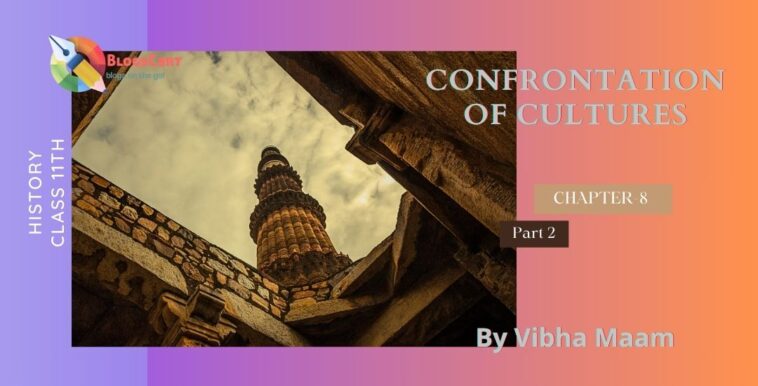In this post, you will learn about the historical events and processes that led to the confrontation of cultures in different regions of the world, such as the Americas, Africa, Asia, and Europe. You will also explore how these encounters influenced the development of trade, religion, art, science, and politics in the modern era.
This post is based on the Class 11 History Chapter 8 Confrontation of Cultures Part-2, which covers topics such as the Columbian Exchange, the Slave Trade, the Rise of Capitalism, the Enlightenment, and the French Revolution.
Voyages of exploration by Europeans
- Portuguese and the Spanish were the pioneers in the 15th century voices of exploration. For a long time, these were called ‘Voyages of discoveries’.
Purposes for voyages:-
Economic
- The European economy went through a decline from the mid 14th to 15th century.
- trade grew slack.
- there was a shortage of gold and silver.
- long distance trade decline.
- Italians managed to do business with Turks with higher trade tax after conquering Constantinople in 1453.
Religious
- The possibility that many more people could be brought into the fold of Christianity made many devout Christian Europeans ready to face adventure.
- As it happened,the ‘crusades’ against the Turks began as a religious war.
- Europeans wanted political control over trade, they had started establishing ‘colonies’ in regions.
- They wanted trade with Asia, especially spices.
- Portugal had gained independence from Spain in 1139.
- They had developed fishing and sailing skills.
Political
- Prince Henry of Portugal (navigator) attacked Ceuta in 1415.
- Africans were captured and enslaved, and gold dust yielded the precious metal.
- In Spain, economic reasons encouraged people to become knights of the ocean
- The memory of Crusades and the success of the Reconquista (military reconquest) encouraged individuals’ ambitions and gave rise to contracts known as Capitulaciones.
- Under the “Capitulancies” the Spanish ruler claimed rights of sovereignty over newly conquered territories and gave rewards to leaders of expeditions in the form of titles and the right to govern the conquered lands.
The Atlantic Crossing
- Christopher Columbus was interested to discover a route to the East (the Indies) by sailing westwards.
- He was inspired by cardinal dle book a work on astronomy and geography in mega mundi return in 1410 is plan was rejected by Portuguese crown but section by section by Spanish authorities he started his expedition that set sale from the part of follows on 3rd August 492
- Columbus and his crew were prepared for the long Atlantic crossing
- The fleet was small, consisting of a small nao(heavy ship, called Santa Maria) and two caravels (small light ships) named Pinta and Nina.
- On 12th October 1492, they had reached the island of Guanahani in the Bahamas. Columbus thought it was India but actually it was a new continent.
- They were welcomed by the Arawaks; they were generous and happy to share their provisions and food with them.
- Columbus planted a Spanish flag in Guanahani (San Salvador) and proclaimed himself viceroy.
- The next expedition forwarded to the larger island of Cubanascan (Cuba, which he thought was Japan) and Kiskeya (renamed Hispaniola, future divided into two countries Haiti and Dominican republic).
- But before they could get very far, the expedition was over taken by fierce Carib tribes. They had to return to the Bahamas.
- Subsequent Columbus voyages revealed that five weeks sailing with the trade wind took one to the other side of the globe.
- Columbus’ achievement has been to discover South America. Columbia is named after Columbus.
- The two continents were named after Amerigo Vespucci, a geographer from Florence, described them as the ‘New World’.
- The name America was first used by a German publisher in 1507.
Spain Establishes an Empire in America
- Spanish expansion was based on a display of military strength with the use of gunpowder and of horses.
- The local people were compelled:
Either to pay tribute or to work in gold and silver mines
- Local chieftains were enlisted to explore new land of gold.
- The greed of gold led to violent incidents provoking local resistance.
- The Spanish friar Bartolome was a severe critic of brutality against Arawaks of the Spanish conquerors.
- Military repression, forced labour and smallpox wreaked havoc on the Arawaks.
- Within half a century, the Spanish had explored and laid claim to a vast area of the Western hemisphere from approx latitudes 40°N to 40° S.
- This was largely the work of two individuals Harman Cortes and Francisco Pizarro.
Cortes and the Aztecs
- Cortex and his soldiers conquered Mexico swiftly and ruthlessly.
- In 1519, Cortes set sail from Cuba to Mexico and allied with Totonacs, a group who wanted to split from Aztec rule.
- People of Tabasco gave Cortes a woman to attend called Dona Marina. She was fluent in three local languages and was able to play a crucial role as interpreter for Cortes.
- The Spanish pressed against the Tlaxcalans, fierce fighters who surrendered only after stiff resistance. the Spanish massacred them brutally.
- Then they marched to Tenochtitlan, which was five times larger than Madrid and had one lakh population.
- Cortes was cordially received by Montezuma but his people were apprehensive after hearing of the massacre of the Tlaxcalans.
- Cortes placed Montezuma under house arrest and attempted the rule in his name.
- Cortes installed Christian image in the Aztec temple.
- At this point, cortes had a leave for Cuba
- The high demanded for gold provoking a general uprising
- Alvarado ( deputy incharge) ordered a massacre during the Aztec spring festival of Huizilpochtli.
- When Cortes returned back on 25th June 1520, he was forced to retreat.
- The Aztec continue to fight the Spanish. 600 conquistadores(Cortes’s Soldiers) and many more of their Tlaxcalan allies were killed in what is known as the Night of Tears.
- After the mysterious death of Montezuma, Cuatemoc was elected a new king.
- By then Aztec were dying from the dreaded smallpox.
- The conquest of Mexico had taken two years.
- Cortes became Captain General of New Spain in Mexico and was showered with honour by Charles V.
- From Mexico, the Spanish extended their control over Guatemala, Nicaragua and Honduras.
Pizarro and the Incas
- Pizarro was uneducated and poor. He had heard stories about the Inca kingdom as a land of silver and gold (El-dor-ado), a city of gold.
- He joined the army and found his way to the Caribbean Island in 1502.
- He showed a beautifully designed gold jar of Inca workmanship to the king of Spain.
- King promised Pizarro the governorship of the Inca lands if he conquered it.
- In 1532, Atahualpa secured the throne of The Inca Empire after a civil war.
- Pizarro captured the king after setting a trap for him. The king offered a room full of gold as ransom for his release.
- but Pizarro did not keep his promise; He killed the king and his followers started looting.
- After this, the country was captured. The cruelty of the conquerors provoked the rebellion in 1554, which continued for two years.
- The Spanish had occupied the vast silver mines in Potosi (in upper Peru, modern Bolivia) in the next five years and they made Inca people into slaves in these mines.
Cabral and Brazil
- Pedro Alvares Cabral set out from Portugal for India with a grand procession of ships.
- To avoid the stormy sea, he lost his way and accidentally reached the coast of present day Brazil.
- There was one natural resource that was Timber .
- The Brazilwood trees,(after which the Europeans named the region Brazil) produced a beautiful red dye.
- The native agreed to cut the trees and carry the logs to the ships in exchange for iron knives and saws.
- This trade in timber led to fierce battles between Portuguese and French traders.
- In 1534,the king of Portugal divided the coast of Brazil into fourteen hereditary ‘captaincies’.
- In1540s, the Portuguese began to grow sugarcane on large plantations and build mills to extract sugar.
- Native refused to work in mills and kept retreating into the forests to escape slavery. plantation owners were forced to turn West Africa for slaves.
- In 1549,a formal government under the Portuguese king was established, with the capital in Bahia (Salvador).
Conquest, Colonies and the Slave Trade
- From the 15th century European Maritime projects produced knowledge of continuous sea passage from ocean to ocean.
- The countries bordering the Atlantic particularly England, France, Belgium and Holland,took advantage of the discoveries.
- Europe also became familiar with new crops from America including tobacco, potatoes, sugarcane, cocoa, rubber and chillies. These were taken by Europeans to other countries like India.
- The consequences of these expeditions for the native of America were physical decimation of the local population, the destruction of their way of life, enslavements, warfare and disease were primarily responsible for this.
- In 1601, Philips ll of Spain publicly banned forced labour. The European settlers were enraged and had forced the king to revoke this law.
- As new economic activities began, the demand for cheap labour continued.
- The local people would resist enslavement, African slaves were imported into Brazil.
- In the 1940s, in his book ‘Capitalism and Slavery’ , Eric Williams was one of the first modern historians to begin to re-evaluate the suffering experienced by African slaves.
Conclusion
European residents of the South American colonies in the early 19th century were to rebel against Spain and Portugal and became independent countries, just as the thirteen North American colonies rebelled against Britain in 1776 and formed the USA.
South America today is also called ‘Latin America’ because of the Spanish and Portuguese languages .
The inhabitants are mostly native European and African by origin, most of them are catholics.
Don’t forget to comment in the comment section below to appreciate the hard work of our author by sharing this notes with your known person you can also Contact us for any query or if you are interested in writing with us.
Stay tuned for more amazing stories, poems & articles like this.
Click here to read first part of this chapter.
Love reading! Checkout Checkfirst bookstore for novels at genuine price.






